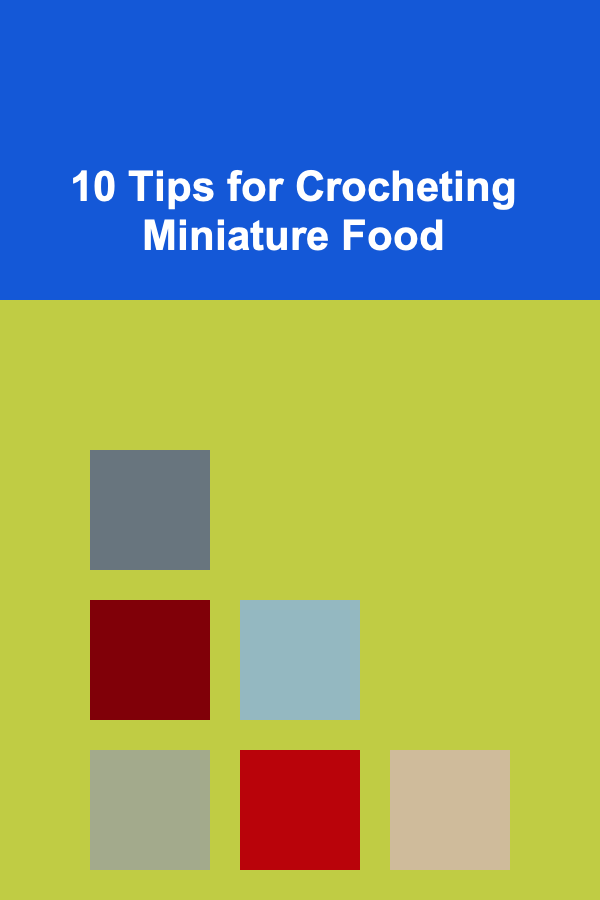
10 Tips for Crocheting Miniature Food
ebook include PDF & Audio bundle (Micro Guide)
$12.99$6.99
Limited Time Offer! Order within the next:

Crocheting miniature food is an art that combines creativity, precision, and a bit of patience. The world of miniature crochet is vast and exciting, offering a unique way to craft delicious-looking creations that are both whimsical and impressive. Whether you want to make food for dolls, keychains, or simply as a fun hobby, crocheting tiny foods can be incredibly satisfying. In this article, we'll cover 10 tips to help you create realistic and delightful miniature food items.
Start with the Right Yarn
When creating miniature food, the first step is selecting the right yarn. The yarn you choose will directly affect the appearance and texture of your finished product. For food items, finer yarns are essential to ensure that your creations look true to scale. Here's what to consider:
- Fingering Weight Yarn: Opt for yarns that are thinner, like fingering weight yarns, to achieve the fine details needed for miniature food. Thicker yarns might create bulky stitches that look out of proportion in smaller projects.
- Cotton Yarn: Many crocheters prefer cotton yarns for food-related projects. They have a smooth finish that mimics the look of real food textures like the crispness of lettuce or the smoothness of a piece of cake. Cotton yarn is also strong and holds its shape well.
- Variety of Colors: Be sure to have a wide range of colors in your yarn stash. Food items require an array of hues, from rich reds for tomatoes to creamy yellows for cheese or muffins. Having multiple color options will allow you to achieve the lifelike shades you need for authenticity.
Choosing the right yarn is crucial to achieving the level of detail you want in your miniature food. Fine yarn will give you more control over the tiny stitches, ensuring that your food items look both neat and realistic.
Use the Correct Hook Size
Selecting the right crochet hook is just as important as picking the right yarn. The hook size will determine how tightly your stitches are worked, which is essential for creating small, detailed projects. Here's how to choose the right crochet hook:
- Smaller Hooks for Detail: To work on miniatures, you'll need a very small crochet hook, typically in the range of 1.5mm to 2.5mm, depending on the thickness of your yarn. A smaller hook will allow you to work tighter stitches, creating a more polished and precise miniature.
- Adjust Hook Size for Different Textures: Different food items might require a slightly different approach. For example, a cake might need a looser, slightly more relaxed stitch, while a strawberry could benefit from tighter stitches to give it a smooth, rounded shape.
Experimenting with different hook sizes for various types of food is a great way to enhance your crochet skills and create realistic textures.
Learn the Basic Stitches and Techniques
Before you can start making miniature food, it's essential to master a few basic crochet stitches. While miniature food can sometimes look intricate, it's generally made up of simple techniques. Here are some fundamental stitches to learn:
- Magic Ring (Adjustable Ring): This is one of the most crucial techniques when working on miniatures, as it allows you to start a project with a tightly closed center. The magic ring is particularly useful for creating circular shapes like pies, cakes, and cookies.
- Single Crochet (sc): This stitch is commonly used in miniature food crochet because of its tight structure, which helps keep the food pieces looking firm and well-shaped.
- Increase and Decrease: Learning how to increase (sc twice in one stitch) and decrease (sc two stitches together) is essential when shaping miniature food. It helps you achieve rounded, realistic shapes like fruit, balls of dough, or burger patties.
Mastering these basic stitches will give you the foundation needed to create realistic miniature food items. Once you're comfortable with these, you can start combining them in various ways to form more complex designs.
Work with Small, Detailed Items
When crocheting miniature food, the details are everything. These small details can make or break the realism of your piece. Pay attention to tiny features that contribute to the lifelike appearance of food, such as:
- Textures and Patterns: Use small stitches to create textures that resemble the surfaces of real food. For example, crochet some raised lines to mimic the texture of a baguette, or create small stitches to add a smooth texture to a pizza crust.
- Adding Embellishments: Tiny elements like beads, buttons, or tiny crochet embellishments can make your food look even more realistic. For example, use small beads for sprinkles on a cupcake, or create miniature leaves from yarn to decorate a piece of pie.
- Tiny Details for Accuracy: For a truly miniature look, add finer details like small slices of fruit on cakes, minuscule chocolate chips in cookies, or delicate patterns on pancakes. These small additions will make the difference between an average piece and a stand-out creation.
The more attention you pay to these details, the more impressive your miniature food will look.
Use Felt and Fabric for Accents
While crochet is excellent for the basic structure of miniature food, combining it with other materials can enhance the appearance of your creations. Felt and fabric can be used to add small, realistic accents that crochet alone might not achieve. Here's how:
- Felt for Details: Felt can be used to create small slices of cheese, fruit skins, or even toppings like pepperoni on pizza. Simply cut out shapes that match your design, and stitch them onto your crocheted pieces. Felt is particularly useful for items that require a solid, smooth texture, such as slices of bread or cheese.
- Fabric for Texture: If you want to give your food a unique texture, you can also use small fabric pieces. For example, use soft fabric to make the inside of a sandwich or a hamburger patty. This can give your miniature food a more realistic and tangible quality.
Felt and fabric details can elevate your crochet projects and provide added realism that yarn alone may not offer.
Use Embroidery to Add Fine Details
Embroidery is another technique that can make your miniature food look even more lifelike. Adding embroidered details like stitching on "seeds," "rinds," or "frosting" can elevate your food projects from simple to spectacular. Here's how you can incorporate embroidery:
- Use Thread for Fine Details: With embroidery thread or yarn, you can add small details like the veins on a leaf, seeds on a watermelon slice, or decorative lines on a cake. A simple backstitch can go a long way in improving the look of your food.
- Create Small Patterns: You can also use embroidery stitches to add small patterns to the surface of your crocheted food. For example, you can create a spiral on the top of a cupcake to mimic frosting, or stitch tiny polka dots on a pancake.
Embroidery allows you to go the extra mile when it comes to creating intricate, lifelike features on your miniature food.
Experiment with Different Shapes and Sizes
Miniature food often involves creating items in various shapes and sizes. One of the fun aspects of crocheting food is the opportunity to experiment with different forms. From fruits and vegetables to complete meals, the options are endless.
- Use Different Shapes for Variety: Don't be afraid to experiment with unusual shapes. Crocheting food allows for a lot of creativity in terms of appearance. For example, you could make a mini hamburger with three layers: the bun, the patty, and the lettuce, or you could crochet a basket of small fruits.
- Scale and Proportion: When making food, remember to maintain scale. If you're creating a mini pizza slice, make sure the crust is proportional to the size of the slice, and the toppings are appropriately placed to maintain balance.
Being open to experimenting with shapes and sizes will help you create a diverse range of miniature food that is both fun and visually appealing.
Use a Fabric Stiffener for Stability
Some miniature foods, like pies, cakes, or cookies, need to maintain their shape. One way to ensure your food items retain their form is by using fabric stiffener or starch. This technique is particularly useful when crocheting larger items like a cupcake or a basket of fruit.
- Apply Fabric Stiffener: After completing your crochet, you can apply fabric stiffener to your project. This will help it hold its shape, especially when working on more intricate and delicate pieces that may lose form without support.
- Shape and Mold: After applying fabric stiffener, you can mold your project into the desired shape and let it dry. This will give your miniature food items a sturdier structure, so they don't lose their shape over time.
Using fabric stiffener is an excellent way to keep your creations stable, especially for items that are more complex or that need to stand up on their own.
Create a Miniature Food Display
Once you've mastered crocheting miniature food, consider displaying your creations. A well-thought-out display can enhance the beauty of your crochet work and allow others to appreciate your talents.
- Use Small Containers or Plates: Display your food on miniature plates, baskets, or glass containers. This not only showcases your work but also makes the food pieces look more realistic.
- Create a Themed Display: Organize your miniature food into a specific theme, such as a bakery, a picnic, or a buffet. This thematic approach makes the display more captivating and enjoyable to look at.
Displaying your crochet food items in a creative way will make your work stand out and give you an opportunity to share it with others.
Practice and Patience are Key
Finally, the most important tip for crocheting miniature food is to practice and be patient. Mastery of the tiny stitches and intricate details takes time. The more you practice, the better you will get at creating realistic food items.
- Start with Simple Projects: Don't rush into complex food items right away. Start with simple things like fruits, vegetables, or a slice of bread, and work your way up to more intricate projects like multi-layered cakes or complete meals.
- Be Patient with Your Progress: Crocheting miniatures can be a time-consuming process, but don't get discouraged. With each new project, your skills will improve, and your creations will become even more detailed and professional-looking.
Patience and practice are essential to becoming proficient at crocheting miniature food. Don't be afraid to take your time and enjoy the process.
Conclusion
Crocheting miniature food is a fun and rewarding hobby that allows for a lot of creativity and attention to detail. By following these tips, you can create food items that are not only adorable but also realistic and finely crafted. Remember to start with the right materials, master the basics, pay attention to small details, and practice patience. Whether you're making miniature food for display, dolls, or as a hobby, the possibilities are endless. Happy crocheting!
Reading More From Our Other Websites
- [Tie-Dyeing Tip 101] How to Tie‑Dye Bed Sheets for a Bold Bedroom Makeover
- [Organization Tip 101] How to Simplify Your Pantry with Meal Planning
- [Organization Tip 101] How to Use Bins and Baskets for Easy Sports Gear Storage
- [Personal Care Tips 101] How to Use Soap for a Gentle Skin Cleanse
- [Home Storage Solution 101] How to Transform Your Home Office Organization with Smart Desk and Drawer Inserts
- [Organization Tip 101] How to Set Up a Minimalist Living Room
- [Organization Tip 101] How to Handle Incoming Paperwork to Reduce Clutter
- [Home Budget 101] How to Start Budgeting for a New Home Purchase
- [Personal Care Tips 101] How to Apply Blush for a Natural, Fresh Look
- [Personal Investment 101] How to Invest in Collectibles and Alternative Assets for Portfolio Diversification

Essential DIY Home Repairs and Maintenance Every Homeowner Should Know
Read More
How to Keep Your Home's Air Conditioning System Running Efficiently
Read More
How to Create a Sensory Garden
Read More
Preparing for Financial Emergencies: A Comprehensive Guide
Read More
How to Create a Landscaping Checklist for Shady Gardens
Read More
How to Design Your Own Modern Quilting Patterns
Read MoreOther Products

Essential DIY Home Repairs and Maintenance Every Homeowner Should Know
Read More
How to Keep Your Home's Air Conditioning System Running Efficiently
Read More
How to Create a Sensory Garden
Read More
Preparing for Financial Emergencies: A Comprehensive Guide
Read More
How to Create a Landscaping Checklist for Shady Gardens
Read More